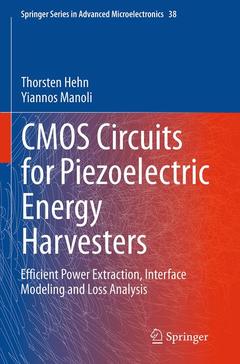CMOS Circuits for Piezoelectric Energy Harvesters, 2015 Efficient Power Extraction, Interface Modeling and Loss Analysis Springer Series in Advanced Microelectronics Series, Vol. 38

This book deals with the challenge of exploiting ambient vibrational energy which can be used to power small and low-power electronic devices, e.g. wireless sensor nodes. Generally, particularly for low voltage amplitudes, low-loss rectification is required to achieve high conversion efficiency. In the special case of piezoelectric energy harvesting, pulsed charge extraction has the potential to extract more power compared to a single rectifier. For this purpose, a fully autonomous CMOS integrated interface circuit for piezoelectric generators which fulfills these requirements is presented.
Due to these key properties enabling universal usage, other CMOS designers working in the field of energy harvesting will be encouraged to use some of the shown structures for their own implementations. The book is unique in the sense that it highlights the design process from scratch to the final chip. Hence, it gives the designer a comprehensive guide of how to (i) setup an appropriate harvester model to get realistic simulation results, (ii) design the integrated circuits for low power operation, (iii) setup a laboratory measurement environment in order to extensively characterize the chip in combination with the real harvester and finally, (iv) interpret the simulation/measurement results in order to improve the chip performance. Since the dimensions of all devices (transistors, resistors etc.) are given, readers and other designers can easily re-use the presented circuit concepts.
1 Introduction.- 2 Piezoelectricity and Energy Harvester Modelling.- 3 Analysis of Different Interface Circuits.- 4 Theory of the Proposed PSCE Circuit.- 5 Implementation of the PSCE Circuit on Transistor Level.- 6 Performance Analysis of the PSCE Chip.- 7 Conclusions and Outlook. References.- Appendix A Mathematical Calculations.- A.1 Solution of the Linear Differential Equation Systems.- A.2 Flux Property.- A.3 Trigonometric Relations.- A.4 Numerical Calculation.
Thorsten Hehn received the Dipl.-Ing. degree in Microsystems Engineering from the University of Freiburg in 2006 and the Dr.-Ing. Degree in Microsystems Engineering from the University of Freiburg in 2014.
Dr. Hehn started his research activity in Energy Harvesting in 2006 during his diploma thesis, which was on an energy harvesting based sensor system exclusively supplied by a vibration based inductive energy harvester. After finishing his studies, he joined the graduate program “Micro Energy Harvesting”, funded by the Deutsche Forschungsgemeinschaft (DFG), where he worked on highly efficient energy extraction from piezoelectric energy harvesters. For this purpose, he implemented switched schemes in low power CMOS integrated circuits, increasing the power which can be extracted from the harvester compared to standard full bridge rectifiers. He also investigated methods of modelling the mechanical harvester structure, which is essential for electrical simulations.
After his time in the graduate program, Dr. Hehn worked on the BMBF project “ASYMOF” on the evaluation and development of an energy autonomous anti-theft alarm system for automobiles. In this project, he developed a wireless sensor node exclusively powered by thermoelectric energy harvesting.
In 2012, Dr. Hehn joined the Institute of Micromachining and Information Technology (HSG-IMIT) as a scientific researcher. Since then, he has developed an education kit for academia, demonstrating the resonance characteristics of vibration based inductive energy harvesters and the influence of different power management components on the output voltage of the harvester. In addition, he has contributed several power management components for gyroscope based sensor readout ASICs.
Yiannos Manoli is the Dean of Engineering and holds the Fritz Huettinger Chair of Microelectronics in the Department of Microsystems Engineering (IMTEK) at the University of Freiburg,Germany. Since 2
Date de parution : 08-2016
Ouvrage de 204 p.
15.5x23.5 cm
Date de parution : 08-2014
Ouvrage de 204 p.
15.5x23.5 cm
Thèmes de CMOS Circuits for Piezoelectric Energy Harvesters :
Mots-clés :
CMOS Circuits; Conduction Losses in CMOS Circuits; Different Interface Circuits; Energy Harvester Modelling; Energy Harvesting; Fully Autonomous Circuits; Integrated Circuit power consumption; Interface Circuit; Low Power; Performance Analysis; Piezoelectric Devices; Piezoelectricity; Pulsed Synchronous Charge Extractor (PSCE); Self-powered Circuits



